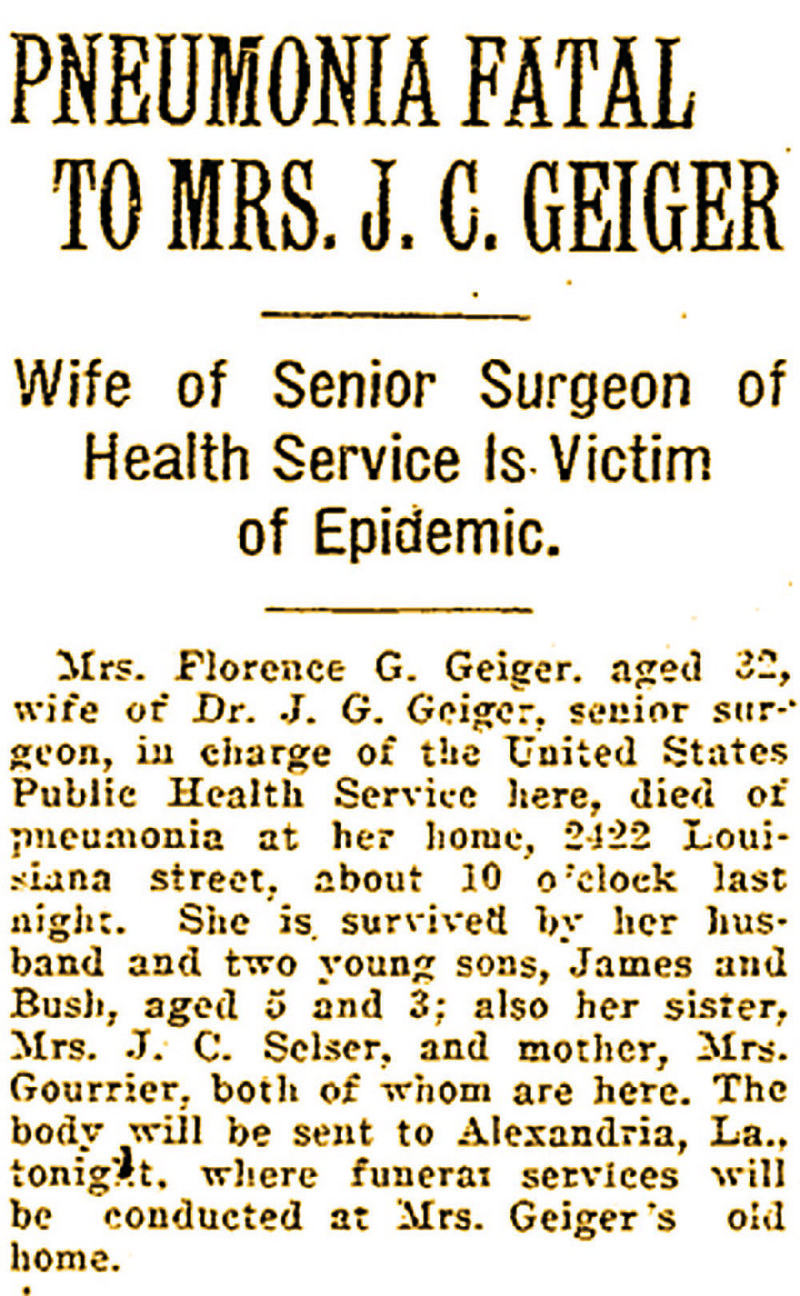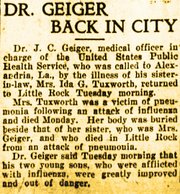While thousands of Arkansans were coughing up their lungs during the flu pandemic of 1918, the U.S. public health officer in charge was Dr. J.C. Geiger.
This 33-year-old physician and epidemiologist — or "epidermologist" as the Arkansas Democrat had it — was a daily presence in the news, tamping down panic about the so-called "Spanish flu." It was bad, he said. Residents should take the only precautions available — get plenty of rest, seek fresh air, avoid close quarters, spit into kerchiefs and not upon sidewalks, and, if they feel sick, stay home and call the doctor at once.
He did not say, but I can imagine him thinking, "Don't write to your boy at Camp Pike and urge him to desert." There were 50,000 soldiers packed into close quarters at Camp Pike and Eberts Field in Lonoke. (See Jack Schnedler's article here.)
The flu crept in while he was completing a deeply researched report about mosquito abatement — involving staining mosquitoes different colors and measuring their flight — and monitoring a scary outbreak of spinal meningitis. Also, he was demanding the return of his research goat, which had vanished from the lawn of the Old Statehouse.
"Doc" Geiger believes that when the captor of the animal knows the 57 varieties of germs which the animal is carrying, Mr. Goat will be liberated hastily.
Meanwhile, there was this flu. Geiger traveled a lot in September and October 1918, visiting the sick, quarantining families and towns, inspecting 155 eating establishments, conferring with his supervisor in Washington. Daily reports on the flu's progress in the camps and outlying communities were sent to him through the mail. Information ran behind reality, and so today he's the guy who downplayed the threat; but he advised the public nearly daily about precautions.
Geiger did this service at enormous personal cost. He caught the flu, and then, about a week later, his wife died of its effects.
Florence Clay Gourrier Geiger was 32 and, as is obvious in the family portrait someone has posted at findagrave.com, lovely. The photo leaves an impression of formality gone awry, thanks to two cute boys. She holds up some pictorial reading material or perhaps needlework while her husband clamps the hand of the younger boy, who is grinning. Papa looks just a tad annoyed. The older boy — he would not have been more than 4 — stares obediently into the camera. They have her thick dark hair.
Geiger took Florence's body home to Pineville, La., for burial and left the boys with his parents in Alexandria. Then he went back to work.
Alexandria was not safer. In January, the boys caught the flu. Their aunt, Florence's sister, caught it from them, and although they recovered, she died.
We know these facts from many items in the archives of the Democrat and Arkansas Gazette, which also tell us that — after he left Arkansas — this man became one of the better-known public health experts in America.
But we will not be able to trace who he became if we go on thinking, as has been reported, that his name was James Geiger. It wasn't.
CRUSADER UNDAUNTED
Dr. Jacob Casson Geiger did not invent the Geiger counter. That was someone else. But "Jake" Geiger did become a celebrated researcher, professor and longtime public health officer for the cities of San Francisco and Oakland, Calif.
He held more than 38 awards, titles and decorations from nations he assisted in the fight against malaria, typhoid, botulism, plague, smallpox, tuberculosis, venereal disease ...
His alma mater, Tulane University in New Orleans, awards the Jacob C. Geiger Gold Medal Award for the best doctoral thesis on a problem of public health.
Crusader Undaunted: Dr. J.C. Geiger, Private Physician to the Public is the title of a 246-page adoring biography of him by Max S. Marshall published by The Macmillan Co. in 1958. This review from the quarterly journal Medical History makes me want to read the book:
To write the biography of a man who is still living is a difficult task, especially for a friend, and some may doubt the wisdom of such an undertaking. Dr. Marshall, Professor of microbiology at the University of California School of Medicine, in a book with a rather journalese title pays a sincere tribute to a great figure in American public health and his fight against malaria, typhoid, typhus, botulism, plague, smallpox, tuberculosis, undulant fever, leprosy, venereal disease, and 'political sepsis'. As befits a colourful subject, the author's style is colourful, and he tells many amusing stories, but his narrative suffers from being too rambling and containing too much that is trivial.
Geiger's work in Arkansas used to be so well remembered that in October 1951, then-Mayor Sam Wassell declared him an honorary citizen of Little Rock.
Doc Geiger was sometimes in the national news:
• In November 1938, a crowd surrounded a girl thrown by a horse in Golden Gate Park. He pushed through the crowd and found himself looking down at his 13-year-old daughter, Anita. She recovered.
• In March 1943, he was advised by city chemists that some hamburger restaurants in San Francisco were serving patties containing 50 percent to 60 percent fat. City ordinance allowed 15 percent. He warned that violators would be prosecuted.
• In November 1949, a Catholic church in San Francisco displayed what purported to be a 15-pound chunk of the Blarney Stone for a three-day festival: 25 cents to kiss the stone. Declaring that unsanitary, Geiger swabbed the stone with a sterile swab and sent it for analysis — but before the results came back, the stone vanished, having raised $472.
James Cullins, past president of the United Irish Society and custodian of the stone groaned:
"The worst thing is that the London Daily Mail's New York correspondent called and said the rock wasn't the real thing."
• In December 1949, Geiger ordered the janitor to spray balconies at the city health center every month with DDT. Because, The Associated Press quoted him as saying, "We have pigeons. The pigeons sometimes carry psittacosis. They also carry mites, and I regret to say, lice. Once in a while I have an itch."
• In November 1951, AP asked him to comment when one Theresa Butler, 60-year-old widow, woke up in the city morgue five days after having been declared dead by her attending physician.
"Apparently," Dr. Geiger said, "we are going to have to alter our opinions of what are the criteria of death."
• In January 1952, he confirmed that he had reserved two rooms at Franklin Hospital in Oakland for Madame Chiang Kai-shek, wife of the Chinese leader. She was flying in for treatment of a skin ailment.
• In March 1955, someone in the Piedmont Pines area of Oakland suspected that a yellow, powdery film on houses and lawns might be fallout from testing of the atomic bomb in Nevada. Civil defense technicians found nothing.
But Dr. J.C. Geiger found plenty. The yellow dust, he declared, was pollen from flowering acacia trees, and "pure poison" for allergy sufferers.
In September 1955, Gov. Orval Faubus and a host of other Arkansas dignitaries sent him congratulations for being named Man of the Year by a health research organization in recognition for his studies of leukemia. He was 70 in 1955, mandatory retirement age in Oakland city government. He retired, but the city retained him as a consultant.
I might be able to go on if I looked at papers other than the Democrat and Gazette, but I haven't even quoted all the stories about him in those archives.
When he died at age 95, his obituary in the San Francisco Chronicle began:
Dr. J.C. Geiger, the most dynamic and articulate health director San Francisco has known, died Saturday at Ralph K. Davies Medical Center.
He is buried beside his second wife, Anne Morse, in her family mausoleum in Oak Grove Cemetery in Bath, Maine.
His tenure in Arkansas began in 1917, and the news clips of his vigorous efforts to sanitize North Little Rock make good reading. I have collected just a few of them into a photo gallery that readers can flip.
Email:
ActiveStyle on 09/24/2018


